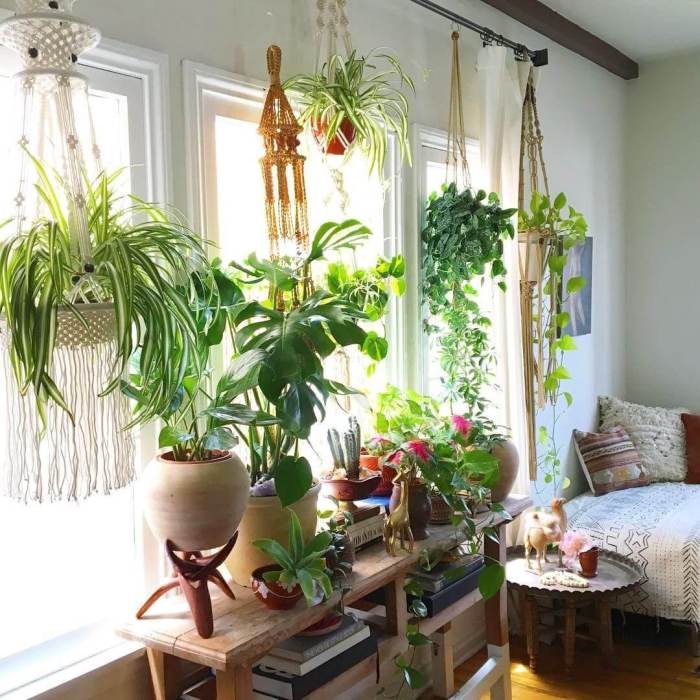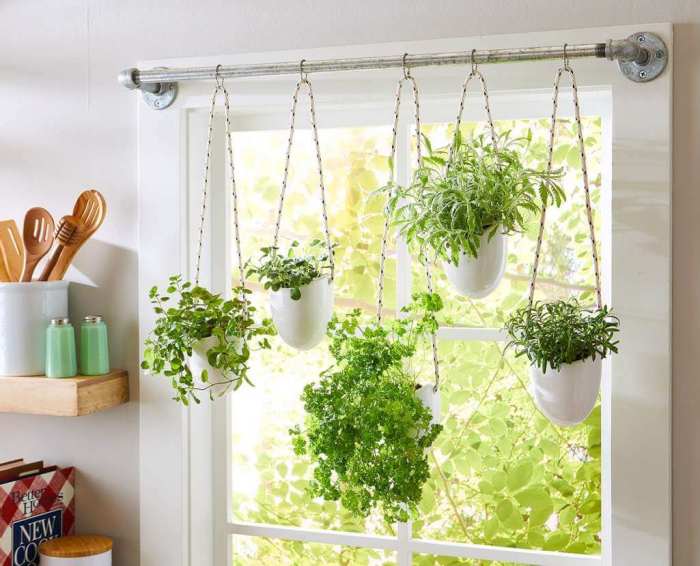Indoor hanging house plants are a captivating and versatile addition to any home, offering a myriad of benefits and creative display options. They bring nature indoors, purifying the air, reducing stress, and fostering creativity.
From air-purifying spider plants to cascading pothos, there’s a wide range of hanging plants to choose from, each with unique characteristics and care requirements. Whether you have a bright and airy living room or a cozy bedroom, there’s a perfect hanging plant to complement your space.
Benefits of Indoor Hanging House Plants
Hanging plants are an increasingly popular way to add greenery and life to indoor spaces. Not only do they enhance the aesthetics of a room, but they also provide numerous health and environmental benefits.
Indoor hanging house plants are a great way to add life and color to your home. They can be used to create a focal point, add privacy, or simply brighten up a space. If you’re looking for a way to add some greenery to your home without taking up too much space, small hanging planters indoor are a great option.
They come in a variety of sizes and styles, so you can find the perfect one to fit your needs. Plus, they’re easy to care for, so you can enjoy your indoor hanging house plants for years to come.
One of the primary benefits of indoor hanging plants is their ability to improve air quality. Plants absorb carbon dioxide and release oxygen through the process of photosynthesis, effectively purifying the air. Certain plants, such as the spider plant, peace lily, and snake plant, are particularly known for their air-purifying abilities.
Reduced Stress and Increased Creativity
Studies have shown that exposure to plants can reduce stress and anxiety levels. The presence of plants in a room can create a calming and soothing atmosphere. Additionally, plants have been linked to increased creativity and productivity, as they provide a source of inspiration and visual stimulation.
Choosing the Right Hanging Plants

Selecting the right hanging plants for your indoor environment is crucial for their health and aesthetic appeal. Consider the following factors when making your choices:
Light Conditions:Determine the amount of natural light available in the area where you intend to hang the plants. Some plants, such as ferns and pothos, thrive in low light, while others, like succulents and cacti, require bright, indirect light.
Humidity:Consider the humidity levels in your home. Tropical plants like ferns and orchids prefer high humidity, while succulents and air plants can tolerate drier conditions.
Maintenance Requirements:Some hanging plants require more frequent watering, pruning, or fertilizing than others. Choose plants that align with your lifestyle and care routine.
For those looking to add a touch of greenery to their indoor space, hanging house plants are a popular choice. They can be used to create a vertical garden, or simply add a bit of life to a room. However, if you’re short on space, or simply want to add some extra style, consider using decorative wall planters indoor . These planters are designed to be hung on the wall, freeing up floor space and creating a unique and eye-catching display.
They come in a variety of styles and materials, so you can find one that fits your décor. And, because they’re easy to care for, you can enjoy your indoor hanging house plants for years to come.
Popular Hanging Plant Varieties
- Spider Plant:Easy to care for, produces plantlets, and purifies the air.
- Pothos:Versatile and low-maintenance, with trailing vines and heart-shaped leaves.
- String of Pearls:Unique and eye-catching, with delicate, bead-like foliage.
- Burro’s Tail:Succulent with trailing stems and plump, green leaves resembling a donkey’s tail.
- Hoya:Slow-growing, with waxy leaves and fragrant flowers.
Each of these varieties has specific characteristics and care requirements. Match them with the appropriate location and conditions in your home to ensure their optimal growth and beauty.
Creative Display Ideas
Hanging plants can elevate any indoor space, offering a touch of nature and a dash of style. Unleash your creativity with these unique display ideas to showcase your verdant companions in a captivating way.
Macrame hangers, with their intricate knots and bohemian flair, add a touch of whimsy to any room. Suspend your plants from these stylish creations for a bohemian-chic look. Wall-mounted planters, available in various shapes and materials, provide a modern and space-saving solution.
They can be arranged in geometric patterns or clustered together for a lush vertical garden effect.
Hanging Planters, Indoor hanging house plants
Hanging planters come in a wide range of materials, including ceramic, metal, and wicker. Choose a style that complements your décor and the size of your plant. For a rustic touch, opt for terracotta or wooden planters. Metallic planters add a touch of glamour, while woven planters bring a bohemian vibe.
Macrame Hangers
Macrame hangers are a popular way to display hanging plants. These intricate knots create a beautiful and unique way to suspend your plants. You can find macrame hangers in a variety of colors and styles, so you can find one that matches your décor.
Wall-Mounted Planters
Wall-mounted planters are a great way to save space and add a touch of greenery to your walls. These planters come in a variety of shapes and sizes, so you can find one that fits your needs. You can mount planters individually or in groups to create a unique display.
Grouped Arrangements
One of the best ways to create a cohesive plant display is to group your plants together. This creates a sense of unity and makes a big impact. When grouping plants, consider the size, shape, and color of each plant.
You can also group plants by type, such as succulents or ferns.
Plant Care and Maintenance
Maintaining the health and beauty of hanging plants requires specific care and attention. Watering, fertilizing, and pruning are essential aspects of their well-being, along with monitoring for potential problems and making necessary adjustments.
Watering
The watering needs of hanging plants vary depending on the species and environmental conditions. Generally, they require less frequent watering than ground-based plants due to improved air circulation. However, it’s crucial to avoid overwatering, as this can lead to root rot.
Allow the soil to dry out slightly between waterings, and water thoroughly when the soil feels dry to the touch.
Fertilizing
Fertilizing hanging plants regularly is essential for providing them with the nutrients they need for optimal growth. Use a balanced liquid fertilizer diluted to half strength and apply it monthly during the growing season. Avoid overfertilizing, as this can damage the roots.
Pruning
Pruning hanging plants helps maintain their shape, encourage new growth, and remove any dead or damaged leaves. Use sharp, clean shears to trim away overgrown stems or remove any yellowing or brown leaves. Pruning should be done regularly to keep the plants healthy and looking their best.
Common Problems and Solutions
Hanging plants are susceptible to various common problems, including:
- Overwatering:Symptoms include yellowing leaves, stunted growth, and root rot. Solution: Reduce watering frequency and improve drainage.
- Underwatering:Symptoms include wilting leaves, brown leaf tips, and stunted growth. Solution: Increase watering frequency and check soil moisture regularly.
- Pests:Aphids, mealybugs, and spider mites are common pests of hanging plants. Solution: Treat with insecticidal soap or neem oil.
- Diseases:Powdery mildew and root rot are common diseases of hanging plants. Solution: Treat with fungicides and improve air circulation.
Regular Monitoring and Adjustments
Regularly monitoring the health of hanging plants and making adjustments as needed is crucial for their long-term well-being. Check for signs of overwatering, underwatering, pests, or diseases. Adjust watering frequency, fertilize regularly, and prune as needed to ensure optimal plant health.
DIY Projects for Hanging Planters

Elevate your indoor greenery with custom-made hanging planters. Unleash your creativity and personalize your space with these step-by-step DIY projects using various materials.
Indoor hanging house plants add a touch of greenery and elegance to any space. For those looking for low-maintenance options, easy indoor hanging plants are a great choice. These plants thrive in hanging baskets or containers and require minimal care, making them perfect for busy individuals or those new to plant care.
By incorporating these easy indoor hanging plants into your home, you can enjoy the benefits of indoor greenery without the hassle.
Macrame Hanging Planters
Craft bohemian-inspired hanging planters using macrame cords. Gather macrame yarn, scissors, and a wooden ring. Knot the cords around the ring and follow intricate patterns to create a unique design. Secure the knots and hang your planter with a hook or string.
Wooden Hanging Planters
Repurpose wooden boards or scraps into charming hanging planters. Cut the wood into desired shapes, sand the edges, and drill holes for suspension. Attach metal chains or leather cords to the holes and hang your wooden planter from the ceiling or a wall mount.
Repurposed Item Hanging Planters
Transform everyday objects into whimsical hanging planters. Use tin cans, plastic bottles, or old teacups. Clean and paint the objects, drill holes for drainage, and attach hanging mechanisms. Suspend them from the ceiling or create a vertical garden by mounting them on a wall.
Last Word: Indoor Hanging House Plants

Hanging house plants are not just a decorative element; they are a living, breathing part of your home. With proper care and attention, they will thrive and bring joy for years to come. So, embrace the beauty and benefits of indoor hanging house plants, and transform your living space into a serene and verdant oasis.
FAQ Guide
What are the benefits of having hanging plants indoors?
Hanging plants indoors offer numerous benefits, including improved air quality, reduced stress, increased creativity, and a touch of greenery to brighten up your space.
How do I choose the right hanging plants for my home?
Consider factors such as light conditions, humidity, and maintenance requirements when selecting hanging plants. Popular varieties include spider plants, pothos, ferns, and succulents.
How do I care for my hanging plants?
Hanging plants typically require regular watering, fertilizing, and pruning. Monitor their moisture levels and adjust your watering schedule accordingly. Prune any dead or damaged leaves to promote healthy growth.